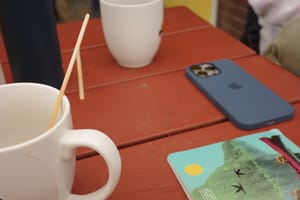It wasn't until a couple years ago, when I was maybe thirty-nine years old, that I even considered the idea that I could sustain a sports injury. Since then I have more or less constantly been nursing something – a scrape, a sprain, a sore muscle. I have almost a fetish for these mostly minor injuries: I don't enjoy getting them, but I find recovering from and adapting to them totally cathartic, as if without these small physical obstacles I wouldn't be sure of my ability to heal from anything at all.
A week and a half ago I dislocated a finger while hurling myself over the handlebars of my mountain bike; I have spent much of the time since then experiencing both subtle and dramatic swings in my outlook and ability to focus. This is, I think, normal — for someone with a dislocated finger, sure, but also for anyone experiencing an unexpected and at least somewhat catastrophic setback. Perhaps this is the source of my fascination with sports injuries: They mimic the injuries we sustain elsewhere in life, and (hopefully) train us to recover from all of life's setbacks a bit better.
SCOPE CREEP.
- As I hinted a few weeks ago, reading When We Cease to Understand the World has so far led me to first worry that I can’t tell the difference between what in the book is historical and what is fiction, and then to more or less stop thinking about the distinction altogether. It’s been an interesting journey; the book is challenging my preconceptions about the purpose of writing about real events that happened in the past, and is reinforcing the idea that whatever you’re reading about, the relationship that you have with the author is probably going to be greater than the relationship you have with the subject matter.
When we read we consume stories, not sequences of events. Stories are ultimately full of the storyteller’s perspective: The act of telling a story is akin to not only shooting a photograph but also choosing a lens, lighting the scene, setting the composition and focus, and then repeatedly retouching the resulting image. Do that a hundred times, and you have a hundred images; then you choose which ones to publish and which to throw away. If I go to a photography exhibit, I do not go in thinking that I’ll receive an unbiased accounting of the visual field the photographer found themselves in. The same should be assumed for written texts, from When We Cease to Understand the World to The Power Broker.
Very tangentially related: Malcolm Gladwell wrote a new book, which seems to be largely about his 2000 hit The Tipping Point, and he spoke with the New York Times about how the “splashy theories” in it have aged over the past quarter century. The quote that least tenuously connects this to the previous paragraphs: “The fun of reading one of my books is not to be converted to a way of thinking. The fun is to meet a new idea and play with it and decide whether you like it, right?” - Last week, in an attempt to feel like I was making progress in life, I spent something like four hours waiting in and milling in the general vicinity of the Downtown Brooklyn Apple Store on Monday. My one-year-old iPhone, which I purchased outright and have been excited to keep alive for at least a couple of years, had been dropped (also while on a bike; a separate incident) and wanted its cameras to be replaced. The experience was suffused with Apple's aesthetic consistency and peppered with operational delights, but it was also rather interminable, and it ended with something of a a moral thud. The repair was initially quoted at just a hundred and sixty-nine dollars and estimated to be ready in an hour and half. It eventually dragged well into the afternoon and resulted in my phone being completely replaced — for twenty percent less than the repair would have cost.
That Apple offers repair services at all is one of the more utopian aspects of the world I inhabit. On the other hand, I found it unnerving to witness their repair services — which exist in a dazzling architectural context — failing so utterly.
I'm glad not to have upgraded to a new iPhone, but it is neat to see Apple integrating some clever technology to make some of the iPhone 16 lineup more repairable: To adhere some new iPhone batteries to the phone's frame, Apple appears to be using an adhesive tape made by Tesa, which debonds when a voltage is applied to it. - A review of the effectiveness of collagen peptide supplementation on (among other things) recovery from tendon and ligament injuries, and a review on the effectiveness of hydrocolloid dressings on (among other things) recovery from superficial sports injuries and other traumatic wounds. I’ve been using hydrocolloid dressings on scrapes, road rash, and deroofed blisters for a couple of years, and find them more comfortable, easier to maintain, and quicker to heal than normal bandages and antibiotic ointment. Last week’s crash was my first substantial connective tissue injury, and I’ve never used collagen peptides before; my hand specialist told me that he had no idea if they’d help my recovery, but they probably wouldn’t hurt.
Read the full story
The rest of this post is for paid members only. Sign up now to read the full post — and all of Scope of Work’s other paid posts.
Sign up now

